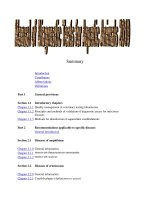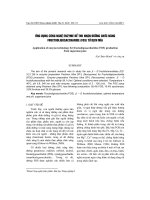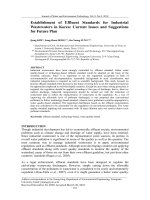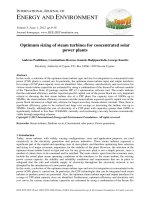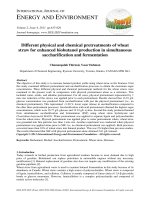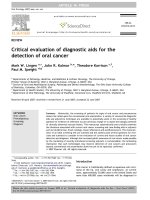manual of diagnostic antibodies for immunohistology
Bạn đang xem bản rút gọn của tài liệu. Xem và tải ngay bản đầy đủ của tài liệu tại đây (1.09 MB, 539 trang )
Page i
Manual of Diagnostic Antibodies for Immunohistology
Page ii
1999
Greenwich Medical Media Ltd
219 The Linen Hall
162-168 Regent Street
London
W1R 5TB
ISBN 1 900151 316
First Published 1999
Distributed worldwide by Oxford University Press
Page iii
Manual of Diagnostic Antibodies for Immunohistology
Anthony S-Y Leong
MBBS, MD, FRCPA, FRCPath, FCAP,
Hon. FHKCPath, FHKAM (Pathol)
Professor of Anatomical and Cellular Pathology
Department of Anatomical and Cellular Pathology
The Prince of Wales Hospital
The Chinese University of Hong Kong
Shatin, Hong Kong
Kum Cooper
BSc (Hons), MBChB, DPhil (Oxon), FFPath, MRCPath
Professor and Head
School of Pathology and South African Institute for Medical Research
University of Witwatersrand
Johannesburg, South Africa
F Joel W-M Leong
MBBS
Clinical Lecturer in Pathology
Nuffield Department of Pathology
John Radcliffe Hospital
University of Oxford
Oxford, United Kingdom
Page iv
To Wendy and Nimmie, for their love, strength and support
Page v
PREFACE
The rapid acceptance and entrenchment of immunohistochemistry as an important and, in some cases,
indispensable adjunct to morphological examination and diagnosis has imposed the necessity for
anatomical pathology laboratories to be proficient in immuno-staining procedures. However, for
immunohistochemistry stains to be meaningful, technical competence must be accompanied by a
familiarity with the characteristics and specificities of the reagents employed. In particular, the medical
technologist and pathologist must have knowledge of the sensitivity and specificity of the primary
antibody employed, the nature of the epitope demonstrated by each antibody and its sensitivity to
common fixatives. They should be equally conversant with protocols for tissue processing as well as the
various methods of antigen/epitope retrieval which are appropriate for the demonstration of the specific
protein sought in the tissue section or cell preparation.
The versatility and contributions of immunohistochemistry to diagnostic pathology, particularly in the
areas of tumor diagnosis, lineage identification, prognostication and therapy are largely dependent on the
ever-increasing range of antisera and monoclonal antibodies which are commercially available.
However, this latter feature is a two-edged sword. While the extensive spectrum of antibodies allows the
identification of a wider and wider range of cellular antigens, the user must also be familiar with the
properties and characteristics of each of these many antibodies.
This book provides a comprehensive list of antisera and monoclonal antibodies that have useful
diagnostic applications in tissue sections and cell preparations. Various clones, which are commercially
available to detect the same antigen, are listed and the sensitivities and specificities of the antibodies are
discussed. Importantly, our own experience with these reagents is provided, together with pertinent
references. While as many available sources of antibodies are provided as possible, it is acknowledged
that the listing cannot be exhaustive and only major sources are covered. A brief coverage of the
diagnostic approach to the general categories of the poorly differentiated round cell and spindle cell
tumors in various anatomical sites using panels of selected antibodies is provided in the form of tables.
Staining protocols and antigen/epitope retrieval procedures, including those employing enzymes,
microwaves and heat, are also given in detail.
It is hoped that this compendium will provide a source of useful and practical information to both the
diagnostic and research laboratory.
ANTHONY S-Y LEONG MBBS, MD
SHATIN, HONG KONG
KUM COOPER MBBCH, DPHIL
JOHANNESBURG, SOUTH AFRICA
F JOEL W-M LEONG MBBS
OXFORD, ENGLAND
Page vi
ACKNOWLEDGEMENTS
We are grateful to the following for their invaluable help during the preparation of this book:
Zenobia Haffajee, Johannesburg
Trishe Y-M Leong, Adelaide
Molly Long, Johannesburg
Michael Osborn, Adelaide
Raija T Sormunan, Hong Kong
Page vii
CONTENTS
Preface
v
Acknowledgements
vi
Introduction
x
Section 1
Antibodies
α
-Smooth muscle actin (
α
-SMA)
3
α
-1-Antichymotrypsin
5
α
-1-Antitrypsin
7
α
-Fetroprotein (AFP)
9
Amyloid
11
Androgen receptor
13
Antiapoptosis
15
Anti-p80 (ALK-NPM fusion protein)
19
Bcl-2
21
Ber-EP4
23
β
-hCG (Human chorionic gonadotropin)
25
CA 125
27
N/97-Cadherin/E-cadherin
29
Calcitonin
33
Calretinin
35
Carcinoembryonic antigen (CEA)
37
Catenins,
α
,
β
,
γ
39
Cathepsin D
41
CD 1
43
CD 2
45
CD 3
47
CD 4
49
CD 5
51
CD 7
53
CD 8
55
CD 9
57
CD 10 (CALLA)
59
CD 103
61
CD 11
63
CD 15
65
CD 19
67
CD 20
69
CD 21
71
CD 23
73
CD 24
75
CD 30
77
CD 31
81
CD 34
83
CD 35
85
CD 38
87
CD 40
89
CD 43
91
CD 44
93
CD 45 (Leukocyte common antigen)
95
CD 54 (ICAM-1)
99
CD 56 (Neural cell adhesion molecule)
101
CD 57
103
CD 68
107
CD 74 (LN2)
109
CD W75 (LN1)
111
CD 79a
113
CD99 (p30/32
MIC2
)
115
c-erbB-2 (Her-2, neu)
117
Chlamydia
119
Chromogranin
121
c-Mvyc
123
Collagen type IV
125
Cyclin D1 (bcl-1)
127
Cytokeratins
129
Cytokeratin 20 (CK 20)
133
Cytokeratin 7 (CK 7)
135
Cytokeratins-MNF 116
137
Cytokeratins-CAM 5.2
139
Cytokeratins-AE1/AE3
141
Cytokeratins-MAK-6 ®
143
Cytokeratins-34
β
E12
145
Cytomegalovirus (CMV)
147
Cytotoxic Molecules (TIA-1, Granzyme B, Perforin)
149
Page viii
DBA.44 (hairy cell leukemia)
151
Desmin
153
Desmoplakins
155
Epidermal growth factors: TGF-
α
and EGFR
157
Epithelial membrane antigen (EMA)
159
Epstein Barr virus, LMP
161
Estrogen receptor (ER)
163
Factor VIII R A (von Willebrand factor)
167
Factor XIIIa
169
Fas (CD95) and Fas-ligand (CD95L)
171
Ferritin
173
Fibrin
175
Fibronectin
177
Fibrinogen
179
Glial fibrillary acidic protein (GFAP)
181
Gross cystic disease fluid protein-15 (GCDFP-15, BRST-2)
183
HAM 56 (macrophage marker)
185
HBME-1 (mesothelial cell)
187
Heat shock proteins (Hsps)
189
Helicobacter pylori
191
Hep Par 1 (hepatocyte marker)
193
Hepatitis B core antigen (HBcAG)
195
Hepatitis B surface antigen (HBsAG)
197
Herpes simplex virus I & II (HSV I & II)
199
HLA-DR
201
HMB-45 (melanoma marker)
203
Human immunodeficiency virus (HIV)
207
Human milk fat globule (HMFG)
209
Human papilloma virus (HPV)
211
Human parvovirus B19
213
Human placental lactogen (hPL)
215
Immunoglobulins: Igk, Ig
λ
, IgA, IgD, IgE, IgG, IgM
217
Inhibin
221
Ki-67 (MIB1, Ki-S5)
223
Laminin
225
Lysozyme (Muramidase)
229
MAS 387 (Macrophage marker)
231
MDM-2 protein
233
Measles
235
Metallothioneins
237
Muscle-specific actin (MSA)
239
Myelin basic protein (MBP)
241
Myeloperoxidase
243
MyoD1
245
Myogenin
247
Myoglobin
249
Neurofilaments
251
Neuron-Specific Enolase (NSE)
253
Neutrophil elastase
255
nm23/NME1
257
P27
kip1
259
p53
261
Pancreatic hormones (insulin, somatostatin, vasoactive intestinal
polypeptide, gastrin, glucagon, pancreatic polypeptide)
263
Parathyroid Hormone-Related Protein (PTHrP)
267
Parathyroid hormone
269
P-glycoprotein (P-170), multidrug resistance (MDR)
271
Pituitary hormones (ACTH, FSH, HGH, LH, PRL, TSH)
273
Placental Aklaline Phosphatase (PLAP)
277
Pneumocystis carinii
279
Pregnancy-specific
β
-1-glycoprotein (SP1)
281
Progesterone receptor (PR)
283
Proliferating Cell Nuclear Antigen (PCNA)
285
Prostate-specific antigen (PSA)
287
Prostatic Acid Phosphatase (PAP)
289
Protein Gene Product 9.5 (PGP 9.5)
291
pS2
293
Rabies
295
Retinoblastoma Gene Protein (P110RB, Rb protein)
297
S100
299
Serotonin
301
Simian Virus 40 (SV40 T antigen)
303
Spectrin/Fodrin
305
Synaptophysin
307
TAG-72 (B72.3)
309
Tau
311
Terminal Deoxynucleotidyl Transferase (TdT)
313
Thrombomodulin
315
Thyroglobulin
317
Page ix
Toxoplasma gondii
319
Ubiquitin
321
Ulex europaeus agglutinin 1 lectin (UAE-I)
323
Villin
325
Vimentin
327
VS38
331
Section 2
Appendices
Appendix 1
Selected antibody panels for specific diagnostic situations
335
Appendix 1.1 Bone/soft tissue-chondroid-like tumors
336
Appendix 1.2 Brain-metastatic carcinoma vs glioblastoma vs
meningioma
336
Appendix 1.3 Childhood-round cell tumors
336
Appendix 1.4 Gastrointestinal and aerodigestive tract mucosa-basaloid
squamous vs adenoid cystic vs neuroendocrine carcinoma
336
Appendix 1.5 Gonads-germ cell tumors vs somatic adenocarcinoma
337
Appendix 1.6 Granulocytic sarcoma vs lymphoma vs carcinoma
337
Appendix 1.7 Intracranial tumors
337
Appendix 1.8 Liver-hepatocellular carcinoma vs metastatic carcinoma
vs cholangiocarcinoma
337
Appendix 1.9 Lung-clear cell tumors
338
Appendix 1.10 Lymph node-round cell tumors in adults
338
Appendix 1.11 Mediastinal tumors
338
Appendix 1.12 Nasal tumors
338
Appendix 1.13 Pelvis-metastatic colonic adenocarcinoma vs ovarian
endometrioid carcinoma
338
Appendix 1.14 Perineum-prostatic vs bladder vs rectal carcinoma
339
Appendix 1.15 Peritoneum-myxoid tumors
339
Appendix 1.16 Pleura-mesothelioma vs carcnoma
339
Appendix 1.17 Retroperitoneum-renal cell carcinoma vs
adrenocortical carcinoma vs pheochromocytoma
339
Appendix 1.18 Retroperitoneum-vacuolated clear cell tumor
340
Appendix 1.19 Skin-adnexal tumors
340
Appendix 1.20 Skin-basal cell carcinoma vs squamous carcinoma vs
adnexal carcinoma
340
Appendix 1.21 Skin-Pagetoid tumors
340
Appendix 1.22 Skin-spindle cell tumors
341
Appendix 1.23 Soft tissue-epithelioid tumors
341
Appendix 1.24 Soft tissue-pleomorphic tumors
341
Appendix 1.25 Stomach-undifferentiated spindle cell tumors
342
Appendix 1.26 Thyroid carcinomas
342
Appendix 1.27 Urinary tract-spindle cell proliferations
342
Appendix 1.28 Uterine cervix-endometrial vs endocervical carcinoma
343
Appendix 1.29 Uterus-trophoblastic cells
343
Appendix 1.30 Uterus-immunophenotyping of syncytiogrophoblast in
trophoblastic proliferations
343
Appendix 1.31 Tissue-associated antigens in "Treatable Tumors"
344
Appendix 1.32 Epithelial tumors which may coexpress vimentin
intermediate filaments
344
Appendix 1.33 Mesenchymal tumors which may coexpress
cytokeratin
345
Appendix 1.34 Tumors which may coexpress three or more
intermediate filaments
345
Appendix 1.35 Abbreviations to antibodies and their sources
346
Appendix 2
Heat induced epitope retrieval and antigen retrieval protocol
347
Heat induced epitope retrieval (HIER)
347
Protocol for heat-induced antigen retrieval using microwaves
348
Section 3
Suppliers
Addresses of suppliers
351
Page x
INTRODUCTION
This book discusses diagnostic antibodies and antisera in alphabetical order and provides the background
and applications of each reagent, together with pertinent references. Common clones of diagnostic
relevance and their sources are listed but this is not presented as exhaustive; furthermore, mainly
antibodies immunoreactive in fixed paraffin-embedded tissue sections are discussed, as these remain the
mainstay of diagnostic histopathology.
Diagnostic Approach
Diagnostic antibodies should not be employed in isolation but always as part of a panel of antibodies
directed to the entities considered in differential diagnosis. As the latter is derived from the
cytomorphologic appearances of the tumor, it is clearly evident that immunohistochemical diagnosis is
morphology based. Indeed, we favor ''immunohistology" over the better established term
"immunohistochemistry" as it emphasizes the relationship of immunostaining to morphology. To assist
with the diagnosis, antibodies to markers recognized to be expressed by the tumor in question, as well as
those associated with the entities considered in differential diagnoses, should make up the panel. As
markers are almost never tissue specific, the application of a panel of antibodies will generate an
immunologic profile comprising both positive and negative findings, which in combination will produce
the most accurate results. By obtaining an immunophenotypic profile of the tissue tested, the errors of
false-positive and false-negative staining will be reduced and the highest diagnostic yield obtained
(Gown & Leong, 1993; Leong & Gown, 1993). For example, anaplastic large cell lymphoma has
carcinoma and melanoma as morphologic mimics. Anaplastic large cell lymphoma may express
epithelial membrane antigen in about 45% of cases and may fail to stain for CD 45 (leukocyte common
antigen) in as many cases. These findings taken in isolation, may be mistaken for that of a carcinoma.
However, if antibodies to vimentin, broad-spectrum cytokeratin, S100 and HMB45
(melanoma-associated antigen) are also employed, the error will be averted as the profile of EMA+,
CD45-,VIM+, CK-, S100-, HMB45- fits best with that of anaplastic large cell lymphoma. In some
situations it may be
Page xi
necessary to perform the immunostaining in two stages. A primary panel of antibodies provides the
major categorization of the tumor and a secondary panel allows further subtyping. For example,
positivity for CD30 will be useful for the confirmation of the diagnosis of anaplastic large cell lymphoma
and lineage typing can be further performed.
As an alternative, the algorithmic approach may be adopted (Leong et al, 1997) but whichever approach
is favored, it is important that antibodies directed to all entities considered in differential diagnosis be
employed. The few exceptions to this rule would include the application of immunostaining for
prognostic markers and the identification of infectious agents in tissue sections.
Standardization and Optimization of Immunostaining
Much has been discussed in recent times about standardization in immunohistology (Taylor, 1993), but
this goal is difficult or impossible to achieve simply because fixatives, durations of fixation and methods
of tissue processing employed by laboratories are different. The ability to demonstrate various tissue
antigens is very much dependent on their preservation and therefore on the method of fixation and
processing employed. With the vastly different practices in laboratories throughout the world, is clear
that standardization as a goal may be impossible to achieve.
It would be more appropriate to aim for optimization of immunostaining within the individual laboratory.
This means consistency, reproducibility and the ability to obtain the optimal results with the method of
fixation and processing employed. To this end, it is necessary for each laboratory to adopt a method of
fixation and tissue processing which will allow the optimal antigen preservation and yet not compromise
cytomorphological preservation. It may be appropriate to examine each fixation and processing step and
adjust for optimization, remembering that antigen preservation may also be influenced by the surgeon or
physician who has responsibility for fixing the excised specimen.
It is imperative to test every new antibody on tissue blocks processed in your own laboratory. While
reagent dilutions and tissue preparation instructions provided by the manufacturers are useful guides,
they are universal recommendations and not individualized. It is necessary to evaluate various methods
of antigen retrieval and to determine, by titration, antibody concentrations that are optimal for tissue
processed in your laboratory. The introduction of the heat-induced epitope retrieval (HIER) procedure
(Shi et al, 1991) has contributed significantly to our ability to optimize immunostaining procedures and
HIER must be evaluated for each new antibody used. With very rare exceptions, we have not found
HIER to be deleterious to the majority of diagnostic antigens and recommend that it be performed as a
routine before any immunostaining (Gown et al, 1993; Leong & Milles, 1993). The combination of
HIER with enzymatic digestion should also be explored for some antigens. A protocol for HIER
employing microwaves is provided in Appendix II.
The diagnostic interpretation in immunohistology includes the assessment of internal positive control
cells or tissues. Although not every tested antigen may have a normal internal counterpart which can be
used for this purpose, test sections do contain such determinants. Positive controls should also be used
routinely in each antibody staining run, remembering that it is more appropriate to employ neoplastic
tissues known to express equivalent amounts of the antigen tested rather than non-lesional tissues which
may express much higher levels of antigen. A negative control of tissues known not to express the
antigen should also be employed. In addition a nonspecific negative reagent control should be employed
in place of the primary antibody to evaluate non-specific staining. Ideally a negative reagent control
contains the same isotype as the primary antibody but exhibits no specific reactivity with human tissues
in the same matrix or solutions as the primary antibody. All control tissues should be fixed, processed
and embedded in a manner identical to the test example.
In addition to these technical aspects, consideration should also be given to the nature of the diagnostic
specificity of the antibodies used and the properties of the target antigen. Much of this information is
theoretical and beyond the control of the diagnostic laboratory. Nonetheless, you should have some
familiarity with this aspect of the reagents and the information is often available in the literature and may
be covered in the product profiles
Page xii
provided by the manufacturer.
It is clear from the foregoing that immunohistology is not a simple matter of a positive or negative stain.
While it is a powerful diagnostic tool, immunostaining is only an adjunct to histologic examination and
requires careful optimization if it is intended to produce the highest diagnostic yield (Leong, 1992).
This book contains antibodies and antisera which we consider to be of diagnostic relevance. Except for
the cytokeratins, pituitary and pancreatic hormones, the antibodies are discussed separately and listed in
alphabetical order for easy reference. The antibodies are indexed by their main and alternative names but
specific clone numbers are not indexed.
How to Use this Book
This book is written by three experts who provide a unique coverage of monoclonal antibodies and
antisera applicable to the field of immunohistology. Each diagnostic antibody is dealt with separately in a
succinct fashion. A comprehensive range of available antibody clones and their sources are listed and a
brief background is given before the applications of the reagents are discussed. In addition, there is an
up-to-date list of important references together with practical tips on immunostaining and interpretation.
The text is cross referenced to an Appendix that contains an extensive assembly of panels of antibodies
for application to a wide variety of diagnostic situations, providing an easy-to-use practical guide. The
addresses of worldwide suppliers of these reagents are included. Also contained in the appendix is a
detailed discussion of antigen retrieval techniques with a detailed protocol of the procedure.
This book will provide essential information for pathologists, technologists and clinicians who employ
antibodies and antisera in their work. It will be an important reference and contains much information for
all those interested in cancer research and biology.
References
Gown AM, Leong AS-Y 1993. Immunohistochemistry of"solid" tumors: poorly differentiated round cell
and spindle cell tumors II. In: Leong AS-Y (ed) Applied immunohistochemistry for the surgical
pathologist. London: Edward Arnold, pp 73-108.
Gown AM, de Wever HT, Battifora H 1993. Microwave-based antigenic unmasking: a revolutionary
new technique for routine immunohistochemistry. Applied Immunohistochemistry 1: 256-231.
Leong AS-Y 1992. Commentary: diagnostic immunohisto-chemistry-problems and solutions. Pathology
24:1-4.
Leong AS-Y, Gown AM 1993. Immunohistochemistry of"solid" tumors: poorly differentiated round cell
and spindle cell tumors I. In: Leong AS-Y (ed) Applied immunohistochemistry for the surgical
pathologist. London: Edward Arnold pp 23-72.
Leong AS-Y, Milios J 1993. An assessment of the effficacy of the microwave antigen-retrieval
procedure on a range of tissue antigens. Applied Immunohistochemistry 1: 267-274.
Leong AS-Y, Wick MR, Swanson PE 1997. Immunohistology and ultrastructural features in
site-specific epithelial neoplasm
an algorithmic approach. In: Leong AS-Y, Wick MR, Swanson PE
(eds) Immunohistology and electron microscopy of anaplastic and pleomorphic tumors. Cambridge:
Cambridge University Press pp 209-240.
Shi S-R, Key ME, Kalra KL 1991. Antigen retrieval in formalin-fixed, paraffin-embedded tissues, an
enhancement method for immunohistochemical staining based on microwave oven heating of tissue
sections. Journal of Histochemistry and Cytochemistry 39: 741-748.
Taylor CR 1993. An exaltation of experts: concerted efforts in the standardization of
immunohistochemistry. Applied immunohistochemistry 1:223-243.
Page 1
SECTION 1
ANTIBODIES
Page 3
αα
-Smooth Muscle Actin (
αα
-SMA)
Sources/Clones
Accurate (1A4), Biodesign (asm-1, A4), Biogenex (1A4), Cymbus Bioscience (asm-1), Dako (1A4),
Enzo (CGA7), ICN (1A4), Immunotech (1A4), Medac (TCS), Novocastra (asm1), RDI (asm-1), Sigma
(1A4) and Zymed (Z060).
Fixation/Preparation
Several of the antibody clones to
α
-smooth muscle actin (
α
-SMA) are immunoreactive in fixed
paraffin-embedded sections. HIER does not significantly enhance staining.
Background
Cytoplasmic actins vary in amino acid sequences and can be separated by electrophoresis into six
different isotopes, all having the same molecular weight of 42 kD.
α
Actins are found in muscle cells.
While
β
and
γ
actins may be present in muscle cells as well as most other cell types in the body,
including non-muscle cells. Both striated and smooth muscle fibers differ in their expression of actin
isotypes and this has formed the basis for the generation of antibodies directed at musclespecific actin
subtypes. HHF35 (muscle-specific actin) identifies all four actin isoforms present in smooth muscle as
well as skeletal muscle cells, pericytes, myoepithelial cells and myofibroblasts. In contrast, antibodies to
α
-SMA specifically identify the single
α
isoform characteristic of smooth muscle cells and those cells
with myofibroblastic differentiation.
Applications
Antibodies to
α
-SMA are used in several diagnostic situations. These include the identification of
myoepithelial cells, which are admixed, with epithelial cells in benign proliferative lesions of the breast,
allowing their distinction from neoplastic proliferations. Myoepithelial cells also line benign ductules of
the breast compared to their absence in neoplastic tubules (Raymond & Leong, 1991).
α
-SMA is also a
useful marker to identify myofibroblastic differentiation and has been used in studies of idiopathic
pulmonary fibrosis (Ohta et al, 1995) and of the fibrogenic Ito cells in the liver (Enzan et al, 1994). In
diagnostic pathology,
α
-SMA is used mostly as a discriminator of smooth muscle tumors in the
identification of spindled and pleomorphic tumors (Jones et al, 1990). It is important to emphasize that
this marker should not be used in isolation (Leong et al, 1997a). Because myogenic determinants are not
always synthesized by normal and neoplastic cells simultaneously, the highest diagnostic yield is
obtained with a panel of antibodies that include
α
-SMA, desmin and muscle-specific actin (Appendices
1.22 and 1.23). In the diagnostic context of the morphologically indeterminate spindle cell tumor, it
should also be remembered that myofibroblasts may express these myogenic markers. However,
expression of desmin tends to be focal and within scattered cells in myofibroblastic proliferations and
these cell types show a thin and fragmented basal lamina compared to the thick, irregular and long runs
of basal lamina around smooth muscle tumors (Leong et al, 1997b). Myofibroblastic proliferations may
display a characteristic "tram track" pattern of distribution of muscle actins distributed in a
subplasmalemmal location. Furthermore, smooth muscle cells may express low molecular weight
cytokeratin.
α
-SMA positivity is also observed in adult and juvenile granulosa cell tumors, and in the
theca externa and focally in the cortex-medulla
Page 4
of the ovary (Santini et al, 1995). The significance of muscle actin expression observed in mesotheliomas
is presently unknown (Kung et al, 1995).
Comments
Clone 1A4 produces the best results in our hands. Immunoreactivity appears not to be enhanced by
HIER or proteolytic digestion.
References
Enzan H, Himeno H, Iwamura S, et al 1994. Immunohistochemical identification of Ito cells and their
myofibroblastic transformation in adult human liver. Virchows Archives 424:249-256.
Jones H, Steart PV, DuBoulay CE, Roche WR 1990. Alpha-smooth muscle actin as a marker of soft
tissue tumors: a comparison with desmin. Journal of Pathology 162:29-33.
Kung IT, Thallas V, Spencer EJ, Wilson SM 1995. Expression of muscle actins in diffuse
mesothelioma. Human Pathology 26:565-570.
Leong AS-Y, Wick MR, Swanson PE 1997a. Immunohistology and electron microscopy of anaplastic
and pleomorphic tumors. Cambridge: Cambridge University Press, pp 64-68.
Leong AS-Y, Milios J, Leong FJ 1997b. Patterns of basal lamina immunostaining in soft-tissue and bony
tumors. Applied Immunohistochemistry 5:1-7.
Ohta K, Mortenson RL, Clark RA, et al 1995. Immunohistochemical identification and characterization
of smooth muscle-like cells in idiopathic pulmonary fibrosis. American Journal of Respiratory & Critical
Care Medicine 152:1659-1665.
Raymond WA, Leong AS-Y 1991. Assessment of invasion in breast lesions using antibodies to
basement membrane component and myoepithelial cells. Pathology 23:291-297.
Santini D, Ceccarelli C, Leone O, et al 1995. Smooth muscle differentiation in normal human ovaries,
ovarian stromal hyperplasia and ovarian granulosa-stromal cell tumors. Modern Pathology 8:25-30.
